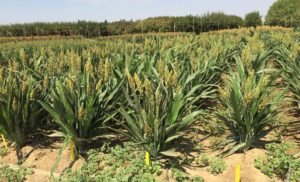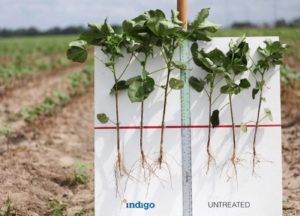Seems like producers in West Tennessee are interested in microbiomes and how bacterial seed coating could help plants to be more drought tolerant later in the growing season.
The microbiome is composed of several different types of organisms, including bacteria, fungi, and viruses. A plant microbiome includes a microbial community that typically interacts extensively with a plant. The plant microbiome can survive either inside or outside of plant tissues. Plant microbiomes can play a beneficial role, protecting the plant from potential pathogens, at the same time, improving growth, health, and production, as well as can conferring an adaptive advantage to plants under extreme environment.
One big question of interest is, can the plant microbiome reduce the amount of pesticides application per acers?
Very recently (May 2018) researchers at College of Natural Resources, UC Berkeley published a study in Proceedings of the National Academy of Sciences of the United States of America (PNAS) on drought obstacles and yield loss. In this study researchers tried to understand and describe the relationship between drought and sorghum’s microbiome.
Researchers learned that under drought conditions, the development of a plant’s microbial community is delayed and the diversity of microorganisms in the root zone decreases. But once a plant’s access to water is restored, its microbiome regains its diversity of bacteria.

The discovery of this drought-induced microbiome enrichment of specific bacteria could offer a potential pathway for manipulating plant microbiomes in crops that are less drought-tolerant than sorghum. https://nature.berkeley.edu/news/2018/04/drought-treatment-restructures-plants-microbiomes
How about microbial seed coating in row crops such as cotton and wheat?
So far, Indigo’s microbe coatings have boosted cotton yields by an average of 14 percent in full-scale commercial trials in Texas (see the figure) and wheat yields by as much as 15 percent in Kansas (source: INDIGO AG, Professor Gregory Sword of Texas A&M University, who led the data analysis).

Not only investigating water deficit stress, Indigo is also investing heavily in research and development efforts to see how microbes influence factors such as nitrogen use and pest resistance, aiming to reduce or even eliminate the use of synthetic pesticides and fertilizers as well as genetically modified seeds. https://www.bloomberg.com/news/articles/2018-04-16/indigo-s-scientists-are-replacing-pesticides-with-bacteria
So far there is increasing interest in using microorganisms as alternatives to pesticides and synthetic products in agriculture in addition to boosting yield under drought conditions. However:
-Blend of microbes that can help the plants (such as cotton, wheat, and sorghum) deal with a variety of biotic (living pests) and abiotic (environmental stressors) situations is still challenging.
-There is no single solution to the challenge of improving the ability of seed inoculants to establish and function consistently in the field under different environmental conditions.
Finally, using the plant microbiome is an interesting option to improve or increase the biological capabilities of the plant, a strategy that, while in its infancy, might be of huge agricultural importance. Obviously, more research is needed to fully understand the potential of plant microbiomes. My program and others at UT are investigating these potential technologies/applications.
Sources:
- http://www.pnas.org/content/early/2018/04/13/1717308115
- https://www.ncbi.nlm.nih.gov/pmc/articles/PMC5253360/
- https://www.sciencedirect.com/science/article/pii/S0944501317311850
- https://www.bloomberg.com/news/articles/2018-04-16/indigo-s-scientists-are-replacing-pesticides-with-bacteria
- https://nature.berkeley.edu/news/2018/04/drought-treatment-restructures-plants-microbiomes

